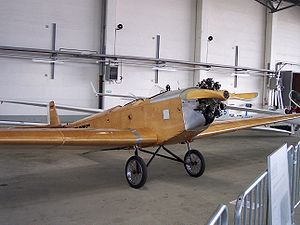Terminal Kl 25
| Clamp L25 | |
|---|---|

|
|
| Type: | Sport plane |
| Design country: | |
| Manufacturer: | |
| First flight: |
1928 |
| Production time: |
1928-1939 |
| Number of pieces: |
about 600 |

The Klemm L25 was an aircraft from Leichtflugzeugbau Klemm GmbH . The factory designation L25 was changed in 1930 with the introduction of the RLM designation to class 25 .
history
The L25 was an evolution of Daimler L20 , which, as Hanns Klemm 1926 self- made, was renamed Klemm L20. Like the L20, this aircraft was a cantilever low- wing aircraft made of wood and was developed in 1927 under the responsibility of Robert Lusser . The main difference to the L20 was the use of more powerful engines, which made it necessary to revise the overall structure. In addition, the now rounded fuselage was completely covered with plywood, which significantly increased the weight of the aircraft.
Depending on the model, the take-off weight was between 620 and 720 kg, the wingspan varied from 10.5 to 13 meters. This results in a surface load of 32 kg / m² with a take-off weight of 650 kg and approx. 36 kg / m² with 720 kg. The take-off speed was between 55 and 60 km / h, depending on the version, the maximum speed between 150 and 160 km / h.
Compared to the usual aircraft of that time, the Klemm construction was very light. According to an advertising leaflet by the Klemm-Werke, the machine needed approx. 25% of the engine power to keep the Kl 25 in the air, while comparable double-deckers needed around 50% of the engine power.
The Kl 25 was built between 1928 and 1939 in around 30 different and constantly improved versions and delivered with engines from 32 kW / 40 PS to approx. 70 kW / 95 PS. The development of the Klemm L 26 was developed as early as 1929 . In addition to a few special variants with floats, snow runners and stub wings, there was also a three-seater variant with the VL25 in which the two passengers sat in front. A total of about 600 copies were built. It was the first German standard training aircraft and was taken out of service during the Second World War and most of it was scrapped, so that only a few airworthy copies have survived today.
The aircraft was produced under license from the British Klemm Airplane Company as the British Klemm Swallow from 1933 .
Since 2010, the Klemm 25 has been rebuilt as a replica by LTB-Follmann near Trier.
Series
incomplete - selection
- L 25 a: built from 1927 to 1929, 22 hp Daimler F 7502 aircraft engine
- L 25 I and IW: built from 1928 to 1929. Radial engine Salmson AD 9 with 45 HP
- L 25 b: 1931, 22 HP aircraft engine from Daimler
- L 25 b VII: 1931, Hirth HM 60 with 60 HP
- L 25 d II: 1933, Siemens & Halske Sh 13a with 88 hp
- L 25 d VII R: mostly built variant from 1934/35 with Hirth HM 60 R with 80 HP
Technical specifications
| Parameter | Klemm L 25 d VII R |
|---|---|
| crew | 1 |
| Passengers | 1 |
| length | 7.5 m |
| span | 13.0 m |
| height | 2.05 m |
| Wing area | 20.0 m² |
| Wing extension | 8.5 |
| Empty mass | 420 kg |
| Max. Takeoff mass | 720 kg |
| Cruising speed | 140 km / h |
| Top speed | 160 km / h |
| Service ceiling | 4800 m |
| Range | 650 km |
| Engines | a HM 60 R with 59 kW (80 PS) |
literature
- Heinz J. Nowarra : The German Air Armament 1933-1945. Bernard & Graefe Verlag, Koblenz 1993, ISBN 3-7637-5464-4 .
- Marton Szigeti: discontinued model. Klemm L 25. In: Classics of Aviation 05/2017, pp. 20–27.
Web links
Individual evidence
- ↑ FliegerRevue, July 2010, pp. 56–59, Hanns Klemm is breaking new ground
- ^ Deutsches Museum: Klemm L 25
